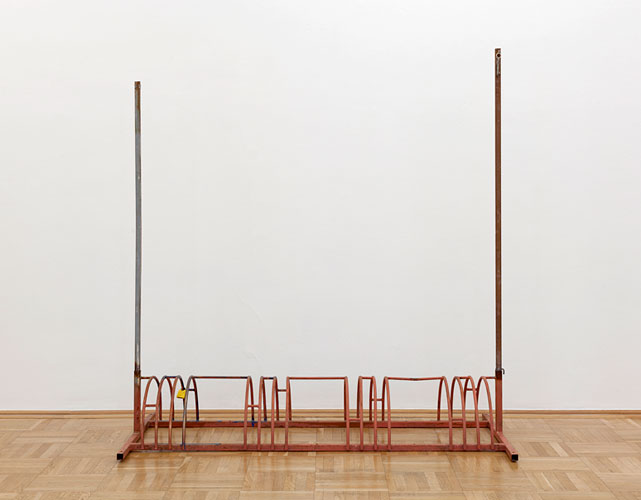“dosen, cassetten, Zeugs”
Manfred Pernice’s sculptures – primarily boxes and containers with cylindrical or cuboid shapes implying a “boxed world” – have recently become more prismatic, plastic positions. The chipboard, plywood, tile, iron and concrete used in these sculptures are materials primarily associated with handicraft, but when combined with texts, drawings, newspaper clippings, photocopies, everyday objects (sometimes found) and other things, these structures create an open system of references that tap into specific socio-cultural codes, memories, or things that have meaning for a certain site. Manfred Pernice’s working methods, which have been described as “blurring” and “direction finding,” are practiced with deliberation. Direction finding means capturing a moment within a kind of order that openly gives in, powerless, to the world’s complexity – an order that could just as soon produce alternative “contexts.” Like the free-floating attention of psychoanalysis, Pernice’s direction finding locates history telling, sorting, separating, and preserving – also of minor or discarded things – and creates a poetic network of mutual references.

‘piccolo’, 2014, MDF, wood, paint, plastic, paper, cardboard, 164,5 x diam. 70 cm (© Galerie Nächst St. Stephan Rosemarie Schwarzwälder)

Figur, 2014, MDF, wood, fabric, metal, 137 x diam. 57,5 cm (© Galerie Nächst St. Stephan Rosemarie Schwarzwälder)
In this exhibition, Manfred Pernice continues his work with boxes by exploring new aspects. Usually shut – their contents concealed (or missing entirely) – some of these boxes are now open, offering up different materials for display. Handouts with information about the works are available on request. Accompanying these boxes are several cassettes positioned on the floor and hanging on the walls. Unlike the boxes, these are entirely open in format. According to Manfred Pernice, “These works explore the relationship between objects, viewers, and their surroundings.
The platform is construed as a system of sorting and separating. It is a sorting system for locating useful materials, or in the sense of separating (waste) as a way of determining the value of individual elements. The relationships between the organized, exhibited objects are optional systems that suggest a (short-term) activation to beholders in the form of an open narrative.” The positioning of the objects is pre-determined but not binding; it is just one many possible variations. The multifaceted snippets in Manfred Pernice’s work tell stories about how society interacts and lives with things.

Cassette 24, 2014, metal, paint, glass, plastic, paper, 42,2 x 42,2 x 4,4 cm (© Galerie Nächst St. Stephan Rosemarie Schwarzwälder)

Bismarck (Zeugs), 2014, MDF, plywood, paint, paper, 2 bicycles, wrench, plastic, metall, glass, tape, light bulb, cabel, 3 parts / 158 x 190 x 150 cm / 50 x diam. 30,5 / 158,5 x 85 x 40 cm (© Galerie Nächst St. Stephan Rosemarie Schwarzwälder)
Grünangergasse 1, 1010 Wien
Until January 22th.
Galerie Nächst St.Stephan Rosemarie Schwarzwälder






